History of the Vale of Leven Page 5
Page 1 | Page 2 | Page 3 | Page 4
Most of these actions had taken place above the Highland Line, and although they clearly had a big impact on Loch Lomondside and the surrounding lands, they had little immediate effect on the lives of the few people who lived in the Vale. Elsewhere in Scotland, however, there were already clear signs of the events, which were to have the biggest impact on shaping the Vale into the entity, which we recognise, to day. The Industrial revolution was flickering into life with iron-works and coal extraction already under way.
Developments in the textile industry, however, were the more important at this time. Linen was the primary Scottish textile, and the attempts of English woollen manufactures after the Act of Union to use Parliamentary duties to cripple Scottish manufacturers proved 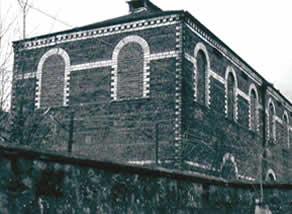 counter-productive. It spurred a number of Glasgow merchants to actively foster the linen industry, and a number of weaving factories were opened, with the plant and knowledge coming from Holland, mostly acquired surreptiously.
counter-productive. It spurred a number of Glasgow merchants to actively foster the linen industry, and a number of weaving factories were opened, with the plant and knowledge coming from Holland, mostly acquired surreptiously.
These efforts proved successful, and by 1750 Parliament recognised that it was wasting its time trying to hold Scotland back and instead introduced a series of measures to encourage linen production.
Within 20 years, by 1772, there were 252 linen factories in Scotland - the majority in Angus, Fife and Perthshire, but some also in the west. The importance of the linen industry for the Vale is that not only did it prepare the way for the cotton industry, but also that it created the demand for the bleaching and dyeing industry.
The first primitive bleach field in the Vale had been laid out in 1715. It consisted of open fields round which beach hedges were grown to prevent the cloth being blown away. Sour milk was poured over the cloth, which was left exposed to the elements for the sun to do its work. It was therefore a summer operation.
More sophisticated chemical-based techniques were 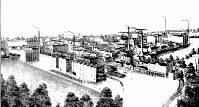 coming into being and there were a number of bleaching and printing works in the Glasgow area by 1750. The best known of these was William Stirling & Sons (Stirling himself was the son of one of the famous Glasgow tobacco merchants) and in 1770 he decided to transfer his works from Dalsholm on the banks of the Kelvin in Maryhill, to Dalquhurn in the Vale of Leven, where the water was plentiful and of exceptional purity, and labour was much cheaper. The modern Vale had begun to take shape as a succession of textile factories were opened and houses built to accommodate those who worked in the factories
coming into being and there were a number of bleaching and printing works in the Glasgow area by 1750. The best known of these was William Stirling & Sons (Stirling himself was the son of one of the famous Glasgow tobacco merchants) and in 1770 he decided to transfer his works from Dalsholm on the banks of the Kelvin in Maryhill, to Dalquhurn in the Vale of Leven, where the water was plentiful and of exceptional purity, and labour was much cheaper. The modern Vale had begun to take shape as a succession of textile factories were opened and houses built to accommodate those who worked in the factories
In 1768 a factory had already been started at Levenfield, which later became part of the Alexandria or " The Craft" Works. This was followed by ...
- 1770 Dalquhurn works and then Cordale in Renton
- 1772 Milton works at what became Jamestown
- 1784 Levenbank works which lay partly in Jamestown and partly Balloch
- 1785 Ferryfield in Alexandria
- 1785 Dalmonach in Bonhill
- 1790 Croftengea Alexandria ("The Craft")
- 1793 Bonhill Printworks or the Wee Field beside Bonhill churchyard
Thus in the space of 20 years or so nine textile factories had been built and opened. We tend to be impressed by the growth in the textile industry in this time, and rightly so. However, the building program was equally impressive from the builders of the day. We don't know who these builders were in the late 18th century, how many there were on each site, where they came from or where they went on to. Some of them no doubt went to work in the factories they built and some must have stayed on in the Vale. So they themselves caused part of the steep increase in population which is noticeable from the late 18th century onwards.
What can be said is that these Vale factories were part of the first wave of large-scale factory building in the UK. The layout of the factories with their lades carrying in water, the  design and construction of the buildings themselves, and of course the machinery used in them, were all on a grand scale never seen before. This was at the leading edge of the textile sector in the Industrial Revolution in Great Britain. Some ideas of the manufacturing processes in the very early stages had been acquired by means unrecorded from Holland. But in the most part, the people who taught the first workers in these factories what their jobs were, must have been self-taught themselves.
design and construction of the buildings themselves, and of course the machinery used in them, were all on a grand scale never seen before. This was at the leading edge of the textile sector in the Industrial Revolution in Great Britain. Some ideas of the manufacturing processes in the very early stages had been acquired by means unrecorded from Holland. But in the most part, the people who taught the first workers in these factories what their jobs were, must have been self-taught themselves.
Something that is often overlooked or with the benefit of hindsight, just taken for granted is that starting up these operations was a huge challenge of confidence, knowledge and commitment. The challenge was more than met by the all the Vale men, women and, it has to be remembered, children involved - builders, management and workers.
It is from this time that the towns and village take names and begin to grow. Renton was founded in 1762, being named by Mrs Jane Telfer-Smollett after her daughter-in-law Cecilia Renton. About 20 years later, in the 1780's the clachan known as “the Grocery” was upgraded to the then village of Alexandria - called after another Smollett, Lt-Colonel Alexander Smollett who was killed a decade or so later in 1799 at the battle of Alkmaar. At this time too, Bonhill began to take shape south along the banks of the Leven from the ferry. Jamestown - which had previously been called Damhead, but was renamed Jamestown in the 1790's because there were several men by that Christian name who lived there, was still just a couple of houses (plus Bonhill Parish school) in spite of having two major works within its boundaries, while Balloch was still essentially a few houses and the Ferry Inn beside the river.
We have accurate figures for the population of the Bonhill parish part of the Vale in 1801 - it was 2,460. Renton would probably have about 1,000 inhabitants. Luss parish had 953 - which was probably about the same as 100 years previously - and Kilmaronock's population was 879.
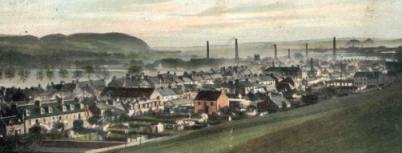
Renton with the Dye Works in the background from Carman Hill
This population growth took place against a general drift from country to town, but it was inevitable that the break-up of the clan system in the Highlands after the failure of the 1745 Jacobite rebellion (which had virtually no direct impact in the immediate vicinity of the Vale, unlike the earlier 1715 revolt), contributed to that growth. Indeed it is likely that most of the population growth up to the 1820's came from people leaving the Highlands and islands. However, the greatest increase in population lay ahead in the 19th century, and it was fuelled by the continued growth and success of the textile industry in the Vale. In the next 40 years or so a further 4 textile factories were built and opened these were:
- 1820's Dillichip Bleach field Bonhill
- 1830 Charleston Engraving works which became part of "the Craft" in Alexandria
- 1836 Kirkland Printworks just north of Dillichip in Bonhill
- 1848 Dillichip Printworks was added beside the existing Dillichip works
In addition to these new factories, new processing and production techniques vastly increased output from all the factories - and increased the demand for raw materials to feed the increase in output. The work force employed in these factories increased dramatically. A comparison involving the three main Vale manufacturers gives clear illustration of this:
| 1835 | 1875 | % Increase | |
| Numbers of parcels of cloth produced | 130,000 | 3,000 | |
| Pieces of cloth printed | 80,000 | 750,000 | 840 |
| Wages paid | £8,800 | £150,000 | 1600 |
| People employed | 350 | 6,000 | 1600 |
| Tons of coal consumed | 4,250 | 100,000 | 2,250 |
These increases of between 10 and 30 times in the forty years straddling the middle of the 19th century were brought about by changes in communications, in what we would now call technology, in the supply of raw materials, in the supply of people, and in demand for the products. The increased activities themselves brought about great changes in the area. And, of course, the world around the Vale was changing with the growth of shipbuilding and other heavy industries on the Clyde which in turn brought massive increases in opportunities and population on the Vale's doorstep
It also introduced in embryonic form what is supposed to be the great white hope for the area's economy to day - tourism. Around the end of the 18th Century the Lochside had already played host to a number of celebrity visitors including Robert Burns, William 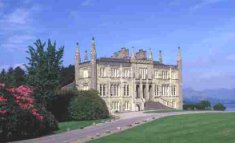 Wordsworth and his sister Dorothy, Doctor Samuel Johnston and Boswell, while Sir Walter Scott was a regular visitor to the area - particularly Ross Priory (pictured) at Gartocharn. Their visits to the area covered in the Loch Lomond section. However, the wealth being generated in and around Glasgow created another type of visitor - the day-tripper. This was not the ma, pa and the weans visitor of the early 20th century onwards, but rather the rich merchants and lawyers types who were initially attracted to sail on the Loch aboard the first steamer on the Loch, the Marion which came into operation in 1818, sailing from in front of the Balloch Hotel up onto the Loch.
Wordsworth and his sister Dorothy, Doctor Samuel Johnston and Boswell, while Sir Walter Scott was a regular visitor to the area - particularly Ross Priory (pictured) at Gartocharn. Their visits to the area covered in the Loch Lomond section. However, the wealth being generated in and around Glasgow created another type of visitor - the day-tripper. This was not the ma, pa and the weans visitor of the early 20th century onwards, but rather the rich merchants and lawyers types who were initially attracted to sail on the Loch aboard the first steamer on the Loch, the Marion which came into operation in 1818, sailing from in front of the Balloch Hotel up onto the Loch.
Before the arrival of the railways in 1850 the rigours they endured to reach Balloch were probably as great as any member of the Loch Lomond expedition of 1715 experienced. They left Glasgow by boat to sail down the Clyde to Dumbarton where they transferred to the Balloch coach. That part was relatively easy, although in the first couple of years some 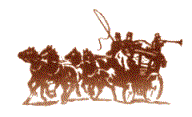 of them would probably still make the journey in some form of sailing boat.
of them would probably still make the journey in some form of sailing boat.
The road between Dumbarton and Balloch presented a greater challenge. A bridge over the Leven had eventually been built in Dumbarton, opening in 1765. Until 1836 and the opening of Bonhill bridge it was the only bridge over the Leven. There were therefore in theory two possible routes to Balloch, either via Renton on a comparatively flat road, but one which left a ferry journey at Balloch, this road took travellers to the west bank of the Leven, while the Marion left from the east bank.
The other, via Bonhill, seems the more direct of the two but was in fact quite rough and hilly with passengers sometimes having to get out and walk up the hills. A number of coaches were available but sometimes they were all full and passengers had to walk the 5 miles to Balloch. On arrival at Balloch, the passengers were transferred by rowing boat to the Marion, there being no jetties to begin with, and set sail on the 60-foot open, steam-driven, paddle steamer. There are various descriptions from passengers who sailed on the Marion of their journeys - none of them mention the word comfortable. However, the scenery was the drawing card rather than creature comforts.
Eventually, there were 2 and then more steamers on the Loch, and it was the attraction of taking passengers to these steamers, which was a primary driving force in promoting interest in bringing the railway to the Vale. That seems astonishing now when you look at the tonnages of coal which were being delivered to the factories, to say nothing of the carriage of finished goods being carried away. In fact the Vale was well served by a variety of boats on the Leven and the Loch - gabbards, barges and scows, and the arrival of the railways and the very considerable increases in commercial tonnages were happily more or less co-incidental.
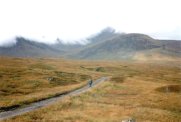 The road system in the area prior to the 45 rebellion was virtually non-existent. What there was was a number of paths and very rough tracks (“horse roads”) which you could walk on and drive livestock over, but which were very rough in the summer for wheeled traffic and muddy in the winter. General Wade, who earned a deserved reputation for military road-building after the 1715 rebellion, concentrated on an access rote to the Highlands and east - west movement in the Great Glen, but built nothing in western Scotland. His successor, Caulfield, achieved a great deal more. He had actually started to build a military road from Dumbarton to Inverary in 1743; it stopped for the 45 but resumed in 1747 being completed about 1749.
The road system in the area prior to the 45 rebellion was virtually non-existent. What there was was a number of paths and very rough tracks (“horse roads”) which you could walk on and drive livestock over, but which were very rough in the summer for wheeled traffic and muddy in the winter. General Wade, who earned a deserved reputation for military road-building after the 1715 rebellion, concentrated on an access rote to the Highlands and east - west movement in the Great Glen, but built nothing in western Scotland. His successor, Caulfield, achieved a great deal more. He had actually started to build a military road from Dumbarton to Inverary in 1743; it stopped for the 45 but resumed in 1747 being completed about 1749.
Because there was no bridge at Dumbarton until 1765 (the stone had been extracted from Kirkton quarry in 1683, yes 1683, and lay on the river bank awaiting the go ahead until the Duke of Argyll fed up with having to get out of his coach to cross the Leven in a ferry on his frequent journeys between the central belt and Inverary, lit a fire under the  Dumbarton burgh councillors), the road initially ran on the east side of the Leven to the ferry at Bonhill, up what is now Bank Street and then along what is now Main Street, along Loch Lomondside to Tarbet, branches off to Arrochar then follows the line of the old A83 over the old Rest and Thankful to Cairndow and the head of Loch Fyne.
Dumbarton burgh councillors), the road initially ran on the east side of the Leven to the ferry at Bonhill, up what is now Bank Street and then along what is now Main Street, along Loch Lomondside to Tarbet, branches off to Arrochar then follows the line of the old A83 over the old Rest and Thankful to Cairndow and the head of Loch Fyne.
The link from Tarbet to Crianlarich was completed between 1752 and 1760, which is supersonic by to-days standards. Its worth noting that was when the stretch of road controlled by the infamous Loch Lomond traffic lights was built and 250 years later we've still not managed to improve on it. Presumably it's the same council team working on it in Dumbarton as took 82 years to get round to building Dumbarton bridge.
A Dumbarton - Stirling military road was also built, using the existing Dumbarton - Bonhill stretch and then Jamestown, Mill of Haldane, Gartocharn and on to Drymen. Most of these roads became turnpikes and tolls were levied for their use. For instance, the road between Drymen and Dumbarton had 3 toll points, while the Loch-shore road in its 40 miles distance between Dumbarton and Arrochar and Inverarnan had 8 tolls. No wonder the cattle-drovers used drove roads, many of which were created after the introduction of tolls. The quality of the road surfaces may have been rough by to-days standards, but these all-weather roads were a huge improvement on what had gone before and indeed are still the basis of our present trunk road system.
For local people, the arrival of the railways when they came had a far greater impact than the improvements in the roads. In 1844 a railway had been proposed between Glasgow and Balloch and Helensburgh by the Caledonian & Dunbartonshire Railway, They could not 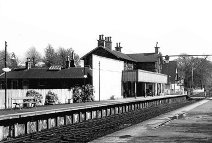 raise enough money for all of that so decided to link Bowling lying as it does on the Clyde and being the western terminus for the Forth & Clyde canal, with Balloch and the Loch Lomond steamers. This would be isolated from all other railway systems, but would be useful for transshipment to the Clyde and the Loch.
raise enough money for all of that so decided to link Bowling lying as it does on the Clyde and being the western terminus for the Forth & Clyde canal, with Balloch and the Loch Lomond steamers. This would be isolated from all other railway systems, but would be useful for transshipment to the Clyde and the Loch.
As it neared completion, its operation was taken over by Messrs Burns who were ship-owners, and who at the same time bought out the owner of the paddle steamer, David Napier. They then built a railway pier 300 feet out into Loch Lomond and this became the terminus for both the railway trains and the steamers. Up until then the steamers had sailed up and down the Leven to Balloch Hotel, when the Leven was high enough. When it was too shallow passengers were punted up the river to its mouth where the steamers were moored, and boarded them there.
The railway opened to the public on 15th July 1850, and was an immediate success. All of the existing stations in the Vale were operational from the beginning, plus of course Balloch Pier, while at the other end Bowling was a port, which still handled Trans-Atlantic traffic as well as the canal boats. Even with just a steamer connection between Bowling and Glasgow, Messrs Burns could still generate enough passenger traffic. to keep 3 steamers busy on Loch Lomond. Balloch became linked to the main railway system in 1856 with the opening of the line to Stirling. From Stirling you could then travel to either Glasgow or Edinburgh. It was not until 1858 that the link between Bowling and Glasgow was completed and you could travel directly from the Vale to Glasgow.
In the 1860's all of these lines became part of North British Railways, while by then the Lochlomond Steamboat Company provided the steamer services connecting with the trains. Thus the railways had arrived in the Vale nicely in time - and mostly conveniently in place - to carry the vastly increased tonnages of coal, raw clothe from Lancashire and finished cloth to and from the factories. All of the factories got their own railway sidings while Dillichip got its own railway bridge over the Leven in 1875. By this time the railways were quite a substantial employer in their own right with an engine shed and extensive yards at Balloch, commercial sidings at every village in the Vale and on the Stirling line, lines off to the factories and a rail-to business and homes delivery system.
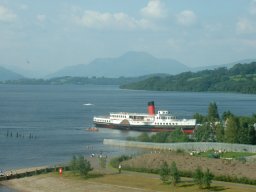
The Maid of the Loch is currently being
restored
at its berth by
what was the old Balloch Pier Station. (Click to enlarge).
In the meantime the road system was being completed with the construction of two road bridges over the Leven to replace the existing ferries at Bonhill in 1836 and Balloch in 1841. The existing ferry operators - at Bonhill, Smollett at Balloch, Colquhoun, on their own terms, which from the start were at the very best of extremely dubious legality. They were toll bridges for which a fee of a bawbee per crossing was required. Since many people had to cross to get to and from work this came to be regarded as a second rent. The sheer exploitation at work caused huge resentment and any anti-toll meeting could usually guarantee a large turnout and a violent ending. To a degree, the issue united the people of the Vale in a way that nothing else did, and certainly radicalised some of them. In spite of the best efforts of virtually the whole community it took until May 1895 for the tolls to be removed.
By 1861 when production was nearing it speak in the local factories, the population of Bonhill Parish had reached 9,000 while that of Renton was probably between 1,500 and 2,000. Kilmaronock was about 1,000, but in contrast the population of Luss had actually dropped by 130 since 1801 to 730.
Page 1 | Page 2 | Page 3 | Page 4


